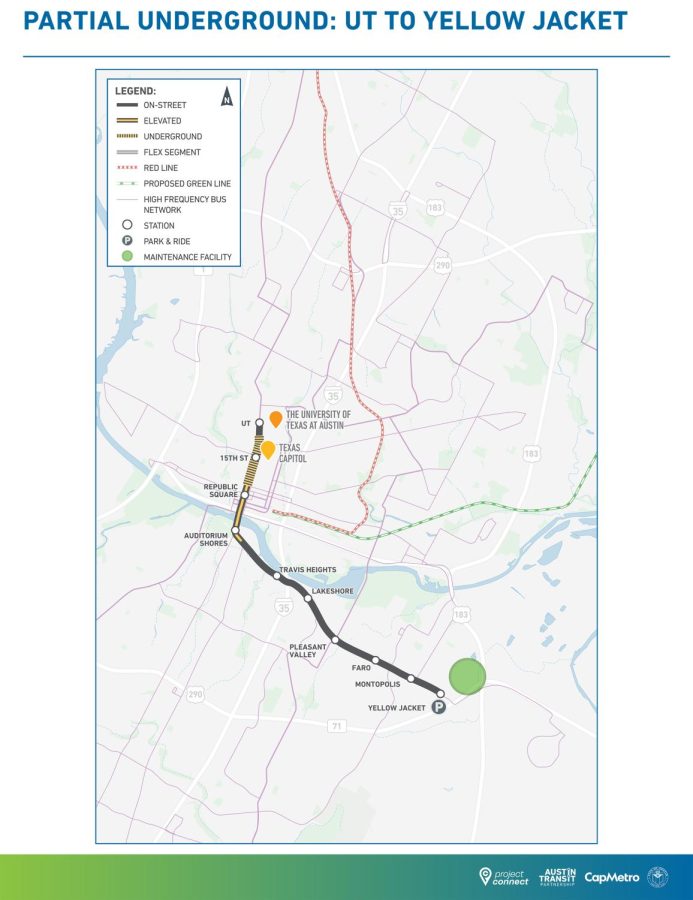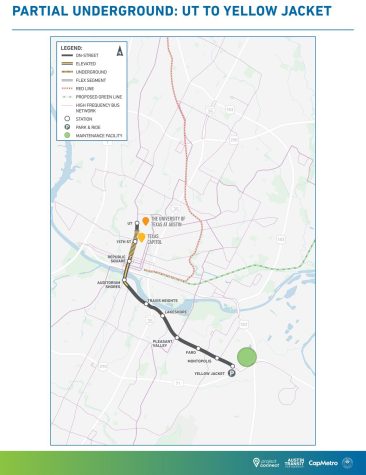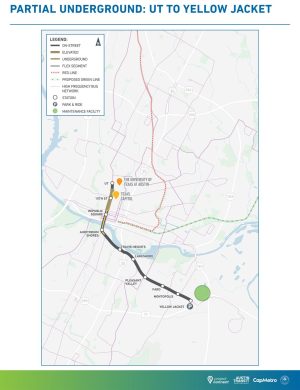New potential Project Connect designs create route intersecting, stopping at UT campus
April 4, 2023
Austin Transit Partnership proposed five new potential light rail lines for Project Connect on March 21, including one connecting UT to Yellow Jacket Lane through downtown.
“We are proud of the work that we have done to ensure that each of the five options is presented to the community for their feedback and input,” the partnership said in an email statement. “(This) will help guide us in our decision making (and will) connect people to the places they want and need to go — jobs, schools, medical appointments, entertainment, sports events and more.”
The proposed line running from the University to Yellow Jacket Lane is a 6.6 mile route with 10 stations serving approximately 20,000 riders daily, according to ATP. ATP stated that the new line would decrease traffic congestion and increase reliability because of its own dedicated light rail lane underground, at ground level and above ground.
According to the partnership, construction is predicted to have minimal impact on the downtown areas. The underground portion spanning from Martin Luther King Jr. Boulevard to 8th Street won’t affect the area’s walkability, except where the shuttles reach the surface.
“The Drag is a central part of Austin’s existing transit,” said Zohaib Qadri, district nine city council member. “I can only imagine how hard it’s been to be a student these past few years with the pandemic and with this ever-changing and ever-growing city that truly suffers not only from an affordability crisis but also from a lack of adequate transit.”
These updates come after the pause of the original lines approved by voters in summer of 2020 due to costs doubling from $5.8 billion to $10.3 billion earlier that year, according to KXAN. Because of rising costs, supply shortages and labor issues, University Democrats treasurer Matt McCoy said the reevaluation of Project Connect is not surprising.
“It needs to (start) as soon as possible — the sooner you get people on board the better,” government junior McCoy said. “The price will only continue to go up, so we need to jump on it while we can.”
Because of the change to the previously-approved plans, ATP is completing an extensive and transparent community engagement process in order to decide which line is best for the city. Austin residents are encouraged to submit online feedback about the lines.
Once a line is chosen, ATP will work with the Federal Transit Administration to study potential impacts under the National Environmental Policy Act before construction starts.
“The University is engaged with CapMetro in ongoing discussions at various touchpoints as they receive stakeholder input and make iterations to the plan,” said Brent Stringfellow, director of campus planning and community liason for Project Connect.
In 2020, there were concerns of business displacement. KXAN confirmed the original $300 million set aside for business displacement in 2020 will still be allocated by ATP after NEPA approval.
“This is not a time that it should lose support,” McCoy said. “We should be going full steam ahead with Project Connect. It does really have the chance to completely reshape the city into a more equitable transit future for everybody.”
In May, ATP will recommend which line to implement based on community feedback, and the City Council, ATP and CapMetro will make the final decision. Currently, construction for Project Connect is estimated to finish in the early 2030s.





